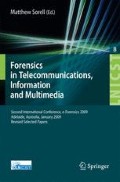Abstract
This article describes techniques of vocal forgery able to affect automatic speaker recognition system in a forensic context. Vocal forgery covers two main aspects: voice transformation and voice conversion. Concerning voice transformation, this article proposes an automatic analysis of four specific disguised voices in order to detect the forgery and, for voice conversion, different ways to automatically imitate a target voice. Vocal forgery appears as a real and relevant question for forensic expertise. In most cases, criminals who make a terrorist claim or a miscellaneous call, disguise their voices to hide their identity or to take the identity of another person. Disguise is considered in this paper as a deliberate action of the speaker who wants to conceal or falsify his identity. Different techniques exist to transform one’s own voice. Some are sophisticated as software manipulation, some others are simpler as using an handkerchief over the mouth. In voice transformation, the presented work is dedicated to the study of disguise used in the most common cases. In voice conversion, different techniques will be presented, compared, and applied on an original example of the French President voice.
The original version of this chapter was revised: The copyright line was incorrect. This has been corrected. The Erratum to this chapter is available at DOI: 10.1007/978-3-642-02312-5_25
Access this chapter
Tax calculation will be finalised at checkout
Purchases are for personal use only
Preview
Unable to display preview. Download preview PDF.
References
Bimbot, F., Chollet, G., Deleglise, P., Montacie, C.: Temporal decomposition and acoustic-phonetic decoding of speech. In: ICASSP, pp. 445–448 (1998)
Duxans, H., Bonafonte, A.: Estimation of GMM in voice conversion including unaligned data. In: EUROSPEECH, pp. 861–864 (2003)
Stylianou, Y., Cappe, O.: Statistical methods for voice quality transformation. In: EUROSPEECH, pp. 447–450 (1995)
Kain, A., Maccon, M.W.: Spectral voice conversion for text to speech synthesis. In: ICASSP, pp. 285–288 (1998)
Perrot, P., Aversano, G., Blouet, R., Charbit, M., Chollet, G.: Voice forgery using ALISP: indexation in a client memory. In: ICASSP, pp. 17–20 (2005)
Tsuge, S., Shishibori, M., Kita, K., Ren, F., Kuroiwa, S.: Study of Intra-Speakers Speech Variability Over Long and Short Time Periods for Speech Recognition. In: ICASSP (2006)
Ortega-Garcia, J., Cruz-Llanas, S., Gonzalez-Rodriguez, J.: Speech variability in automatic speaker recognition systems for forensic purposes In: IEEE 33rd Annual International Carnahan Conference (1999)
Benzeghiba, M., De Mori, R., Deroo, O., Dupont, S., Erbes, T., Jouvet, D., Fissore, L., Laface, P., Mertins, A., Ris, C., Rose, R., Tyagi, V., Wellekens, C.: Automatic speech recognition and speech variability: A review. Speech Communication 49(10-11), 763–786 (2007)
Kunzel, H.J.: Effect of voice disguise on fundamental frequency. Forensic Linguistics, vol. 7 (2000)
Kunzel, H., Gonzalez-Rodriguez, J., Ortega-Garcia, J.: Effect of voice disguise on the performance of a forensic automatic speaker recognition system. In: Odyssey (ed.), pp. 153–156 (2004)
Genoud, D., Chollet, G.: Voice transformations: Some tools for the imposture of speaker verification systems. Advances in Phonetics. Franz Steiner Verlag (1999)
Masthoff, H.: A report on voice disguise experiment. Forensic Linguistics, vol. 3 (1996)
Orchard, T., Yarmey, A.: The effect of whispers, voice sample duration, and voice distinctiveness on criminal Speaker Identification. Applied Cognitive Psychology vo 9(3), 249–260 (1995)
Perrot, P., Chollet, G.: The question of disguised voices. In: Acoustics 2008, Paris (2008)
Reich, A.R., Duke, J.E.: Effect of selective vocal disguise upon speaker identification by listening. Journal of Acoustical Society of America 66, 1023–1028 (1979)
Author information
Authors and Affiliations
Editor information
Editors and Affiliations
Rights and permissions
Copyright information
© 2009 ICST Institute for Computer Science, Social Informatics and Telecommunications Engineering
About this paper
Cite this paper
Perrot, P., Morel, M., Razik, J., Chollet, G. (2009). Vocal Forgery in Forensic Sciences. In: Sorell, M. (eds) Forensics in Telecommunications, Information and Multimedia. e-Forensics 2009. Lecture Notes of the Institute for Computer Sciences, Social Informatics and Telecommunications Engineering, vol 8. Springer, Berlin, Heidelberg. https://doi.org/10.1007/978-3-642-02312-5_21
Download citation
DOI: https://doi.org/10.1007/978-3-642-02312-5_21
Publisher Name: Springer, Berlin, Heidelberg
Print ISBN: 978-3-642-02311-8
Online ISBN: 978-3-642-02312-5
eBook Packages: Computer ScienceComputer Science (R0)

